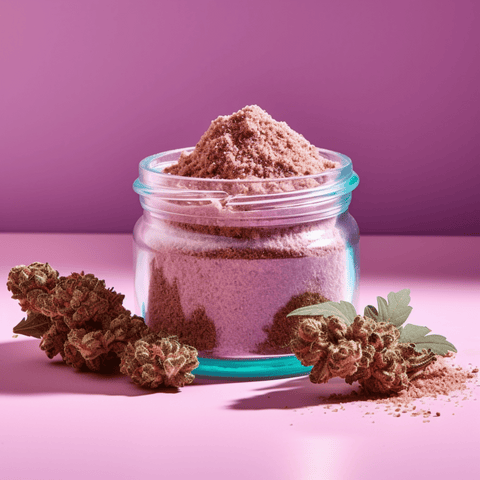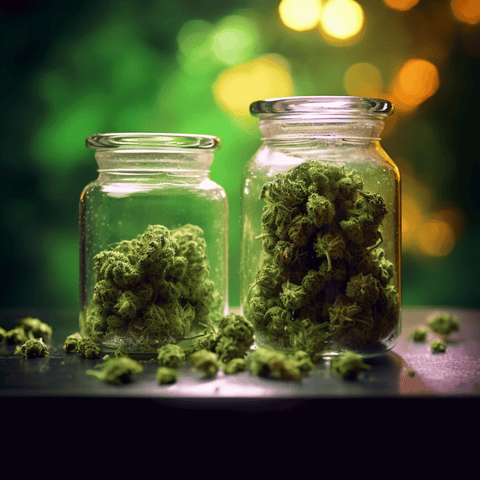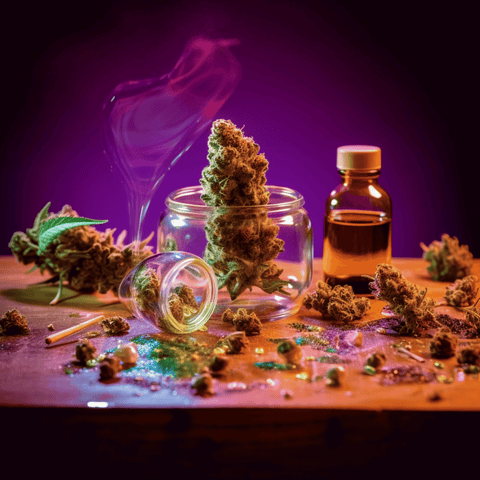Unveiling the Mystery: TAC vs THC in Cannabis

TAC and THC are integral elements of cannabis characterization and experience. TAC, or Total Active Cannabinoids, is a measure of all the active cannabinoid compounds within a cannabis product, encompassing elements like THC, CBD, CBN, and more, offering a comprehensive view of the product's potential effects.
On the other hand, THC, or Tetrahydrocannabinol, is a single cannabinoid, renowned as the primary psychoactive component in cannabis. It's responsible for the 'high' sensation and other effects, and its presence often dictates the potency of the cannabis product. In essence, while THC focuses on the intensity of the experience, TAC provides a broad spectrum view, outlining the product's full cannabinoid profile.
Let's delve deeper into the realms of THC and TAC, their distinct and overlapping qualities, and the role of these compounds in the user experience.
What is THC?
Tetrahydrocannabinol, better known as THC, is the star of the cannabis show. As the most abundant cannabinoid in the plant, it’s infamous for its intoxicating, mind-altering effects that are synonymous with the sensation of a “high.” Strains heavy in THC are celebrated for inducing a range of outcomes, such as euphoria, creativity, tranquility, or profound relaxation.
But a critical point to note here is that the rainbow of effects isn't solely attributable to THC. The presence of other active compounds in the plant plays a significant role too. The cannabinoids we inhale undergo conversions over time, resulting in different effects.
Take, for example, THCA, or tetrahydrocannabinol acid, which is non-psychoactive in its natural state. It only morphs into the psychoactive THC that we are familiar with when heated or decarboxylated.
Merely focusing on THC levels might lead to an underestimation of the strength and impact of a specific product or strain. That's where the story of TAC starts to unfold.

What is TAC?
Total Active Cannabinoids (TAC) represents the comprehensive concentration of active cannabinoids in a cannabis sample. Unlike pharmaceuticals that usually contain a single active compound, cannabis possesses a broad spectrum of active molecules.
Cannabis, comprising both hemp and marijuana, is estimated to contain over 400 compounds, with over a hundred identified as cannabinoids. These active compounds can be broadly categorized into:
- Cannabinoids
- Terpenoids
- Flavonoids
- Alkaloids
- Glycoproteins
Cannabis products are gauged by their TAC value, which measures the combined concentration of all active cannabinoids. Some key cannabinoids worth mentioning include:
Tetrahydrocannabinol (THC)
Often seen as the flagship cannabinoid, THC or delta-9-tetrahydrocannabinol, is the principal component of cannabis. It is responsible for inducing the euphoria or "high" associated with marijuana consumption. The intensity of the high is typically proportional to the concentration of THC.
Cannabidiol (CBD)
Following THC, CBD has garnered considerable attention for its potential health benefits, including stress and inflammation relief. The TAC value encompasses any CBD present in the product, and unlike THC, CBD is non-intoxicating.
Cannabinol (CBN)
Recognized as the 'sleep cannabinoid', CBN is known for its potential therapeutic benefits. Early research indicates CBN may alleviate pain and enhance sleep, all without causing intoxication.
Cannabigerol (CBG)
CBG, like CBD, can reduce the psychoactive effects of THC. It is speculated to exert its effects via the endocannabinoid system or the alpha-2 adrenergic receptors, which modulate the activity of the sympathetic nervous system.
Cannabichromene (CBC)
First identified half a century ago, the benefits of CBC remain relatively unexplored. Like THC and CBD, it also stems from cannabigerolic acid (CBGA). However, there is much to learn about these lesser-known cannabinoids and their impact on human biology.

THC Vs TAC: Delineating Their Differences
The differentiation between TAC and THC brings us to the heart of the cannabis conversation - the diverse roles and influences of these compounds in cannabis products. It's a comparison of the part (THC) to the whole (TAC), with each playing a unique role within the plant's chemical makeup and its impact on the human body.
TAC gives a holistic perspective of a cannabis or hemp plant's entire chemical profile, enumerating all its active components. This includes not only THC but also a variety of other cannabinoids like CBD, CBC, CBG, and CBN. By taking into account the full cannabinoid spectrum, the TAC provides an indicator of a product's overall potency.
This comprehensive measure is essential as research suggests that the interactive effects of multiple cannabinoids may enhance the therapeutic benefits of cannabis, a phenomenon known as the "entourage effect".
In contrast, THC, or delta-9-tetrahydrocannabinol, is a single, albeit significant, active compound in cannabis. As the primary psychoactive component, THC creates the euphoric sensation, or the "high", often associated with marijuana use.
Despite its prominence, the presence of THC does not fully encompass the potential effects or therapeutic benefits of a cannabis product. This is where TAC comes in, adding layers of complexity and therapeutic potential by considering the whole spectrum of active cannabinoids.
The differential impacts generated by THC and other TAC compounds can be traced back to their unique interactions with the endocannabinoid system (ECS) in the human body.
This system, composed of cannabinoid receptors, enzymes, and endocannabinoids, plays a critical role in maintaining physiological homeostasis. THC exerts its psychoactive effects primarily by binding to the CB1 receptor, which is most abundant in the brain and central nervous system.
On the other hand, other cannabinoids within the TAC have different binding affinities and mechanisms, leading to a variety of effects. For instance, CBD, another prominent cannabinoid, has a low affinity for CB1 and CB2 receptors but interacts with other non-cannabinoid receptors and ion channels to exert its therapeutic effects.
Moreover, when we look at product labeling, a crucial distinction needs to be made between THC and Total THC. The latter is a measure of the maximum potential potency of a product, taking into consideration both the active THC and the acid precursor, THCA, which can be converted into THC through a process called decarboxylation.
According to a 2018 study, THCA makes up a significant proportion of total THC in most cannabis strains, highlighting the importance of considering Total THC for a more accurate understanding of a product's potency.
While THC is a pivotal component in the cannabis matrix, it is TAC's holistic view that provides a broader understanding of the plant's potential effects and benefits. A comprehensive understanding of both THC and TAC can guide users towards an informed and responsible cannabis experience.

Unraveling the Relationship Between THC and TAC
THC and TAC are intrinsically interlinked in the sphere of cannabis consumption. The entourage effect, a phenomenon suggesting that cannabinoids and terpenes can enhance each other's effects, highlights that the cannabis experience is best delivered when the full spectrum of the plant profile is consumed.
There is increasing evidence pointing towards the benefits of a combined effect of cannabinoids. Understanding their interaction can help consumers fine-tune their experience.
For instance, studies into CBD and its antipsychotic effects have shown that it can potentially mitigate the psychoactive effects of THC. Thus, if a person consumes excess THC, they can temper the high by ingesting CBD.
The emergence of ratioed products offering balances between THC and CBD has opened up new avenues for consumers to explore. Our understanding of other cannabinoids and their impact on the user experience is also growing with increased funding for cannabis research.
CBGA (Cannabigerolic acid), often dubbed as the "mother of all cannabinoids," is the precursor to several cannabinoids, including CBD and THC. A look at a plant's TAC can enable consumers and researchers to gain a more nuanced understanding of each strain's potential effects and benefits.
The Role of TAC in the “Entourage Effect”
The concept of the entourage effect revolves around the collective impact of active cannabinoids and other compounds recorded in the TAC analysis.
A comprehensive examination through TAC testing can shed light on the interplay of these compounds and their effects both individually and on each other.
Research into specific cannabinoids has also unearthed potential benefits they might have when consumed independently. Today, consumers looking to tap into the benefits of a particular cannabinoid can turn to isolates that refine the plant down to a single compound.
Conversely, for those who prefer a holistic plant profile, TAC analysis becomes particularly useful in understanding the various cannabinoids, terpenes, and flavonoids that will determine the effects, flavor, and aroma a strain produces.
THC and TAC in Different Products
The contents of THC and TAC can vary significantly across different cannabis products. This is due to diverse extraction processes, the type of cannabis strains used, and the specific formulation of the product.
Here are some common types of products where you may encounter THC and TAC:
- Flower: The dried bud of the cannabis plant, often smoked or vaporized, is a common choice for many cannabis users. Both THC and TAC levels are considered in determining the potency and potential effects of a particular strain.
- Edibles: Products such as cookies, gummies, and chocolates can contain varying levels of THC and other cannabinoids. The overall TAC in these products can provide insight into the full cannabinoid profile you'll ingest.
- Tinctures and Oils: These are often used for precise dosing, particularly for medicinal purposes. Both THC and TAC are important considerations, helping users choose the product that best aligns with their needs.
- Topicals: Products like creams and balms typically contain THC, CBD, and a range of other cannabinoids. These products don't typically provide a 'high', but the TAC can give insights into the product's potential therapeutic benefits.
- Vapes and Concentrates: These high-potency products often focus on THC content. However, understanding the TAC can provide a more comprehensive view of the product's potential effects and benefits.
Implications for the Cannabis Industry
The rising awareness and understanding of TAC versus THC have significant implications for the cannabis industry, including:
-
Greater Transparency: Cannabis consumers are increasingly demanding transparency about what’s in their products. The TAC provides a more comprehensive view of a product’s cannabinoid profile, promoting transparency and informed decision-making.
-
Enhanced Product Differentiation: With TAC, producers can differentiate their products based on a more holistic representation of their cannabinoid profile, rather than just THC content.
-
Informed Regulations: As regulators become more educated about the complexity of cannabis, they may look to TAC as a more representative measure of product potency.
-
Improved Consumer Education: Knowledge of TAC can help consumers better understand the potential effects and benefits of different strains, promoting more informed and responsible usage.

Concluding Thoughts
When it comes to cannabis, the saying "knowledge is power" rings particularly true. By understanding the significance of TAC and THC, consumers are empowered to make more informed decisions.
Whether for medicinal use, personal enjoyment, or wellness enhancement, the more we understand these compounds and how they work together, the better we can harness the plant's potential.
So next time you're considering a cannabis product, remember:
- The THC content isn't the only important factor; understanding the full spectrum of active cannabinoids is crucial for predicting effects and benefits.
- The TAC offers a holistic view of the active compounds in a cannabis product.
- Both THC and TAC have their roles in shaping the cannabis experience.
- Cannabis affects everyone differently, so personal experimentation is key to finding what works best for you.
- Always source your cannabis products from reputable suppliers who provide comprehensive lab testing results, including TAC and THC content.
With continued research and increased understanding, we look forward to a future where every cannabis consumer can make their choices based on comprehensive and easily accessible information.
For More Information
We understand that the complexity of cannabis can feel overwhelming. That's why we're committed to providing you with the most accurate, up-to-date, and comprehensive information possible.
For more insights, guides, and discussions on THC, TAC, and the fascinating world of cannabis, please visit our website.
Whether you're seeking more detailed information, advice on choosing products, or simply wanting to stay updated with the latest cannabis research, we're here to empower you on your journey.
Navigate the ever-evolving landscape of cannabis with confidence, armed with knowledge and supported by our dedicated team of experts.
Explore our comprehensive resources today - we look forward to supporting you on your journey towards an enriched understanding of cannabis.
In the world of cannabis, knowledge is indeed power. Equip yourself with it.





